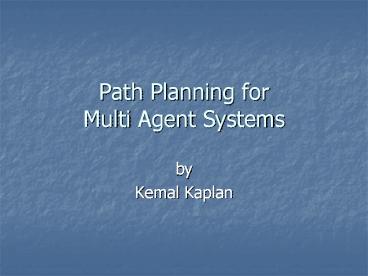Path Planning for Multi Agent Systems - PowerPoint PPT Presentation
1 / 21
Title: Path Planning for Multi Agent Systems
1
Path Planning forMulti Agent Systems
- by
- Kemal Kaplan
2
Multi Agent Systems (MAS)
- A multi-agent system is a system in which there
are several agents in the same environment which
co-operate at least part of the time. - Complexity of the path planning systems for MAS
(MASPP) increase exponentially with the number of
moving agents.
3
Problems with MASPP
- Possible problems of applying ordinary PP methods
to MAS are, - Collisions,
- Deadlock situations, etc.
- Problems with MASPP are,
- Computational overhead,
- Information exchange,
- Communication overhead, etc.
4
Classification of Obstacles
- Usually other agents are modelled as unscheduled,
non-negotiable, mobile obstacles in MASPPs. - Category of Obstacles from Arai et. al. (89)
5
Proposed Techniques
- Centralised Approaches
- Decoupled Approaches
- Combined Techniques
6
Centralised Approaches
- All robots in one composite system.
- Find complete and optimum solution if
exists. - Use complete information
- - Computational complexity is exponential w.r.t
the number of robots in the system - - Single point of failure
7
Decoupled Approaches
- First generate paths for robots (independently),
then handle interactions. - Computation time is proportional to the
number of neighbor robots. - Robust
- - Not complete
- - Deadlocks may occur
8
Combined Techniques
- Use cumulative information for global path
planning, use local information for local
planning - Think Global Act Local
9
Utilities For Combined Techniques
- Global Planning Utilities
- The aim is planning the complete path from
current position to goal position. - Any global path planner may be used. (e.g. A,
Wavefront, Probabilistic Roadmaps, etc.) - Requires graph representation achieved by cell
decomposition or skeletonization techniques.
10
Utilities For Combined Techniques (II)
- Local Planning Utilities
- The aim is usally avoid obstacles. However,
cooperation should be used also. - Any reactive path planner can be used. (e.g.
PFP, VFH, etc.) - No global information or map representaion
required. Decisions are fast and directly
executable.
11
Improvements for Combined Techniques
- Priority assignment
- Aging (e.g. the forces in a PFP varies in case of
deadlocks) - Rule-Based methods (e.g. left agent first, or
turn right first) - Resource allocation (leads to suboptimal
solutions)
12
Improvements for Combined Techniques (II)
- Robot Groups
- A leader and followers
- Many leaders (or hierarchy of leaders and
experience) - Virtual leader
- Virtual dampers and virtual springs
- Assigning dynamic information to edges and
vertices
13
Possibe MAS environmets for MASPP
- Robocup 4-Legged League
- Robocup Rescue
- SIMUROSOT, MIROSOT (?)
- Games (RTS, FPS)
- ...
14
MASPP Example ARAI OTA 89
- Measures
- Computational Load
- Total length of the generated trajectories
- The radius of curvature of the generated
trajectories - Total motion time
- Preferred measure is the first one
15
MASPP Example ARAI OTA 89
- Properties of agents
16
MASPP Example ARAI OTA 89
- Problem 1
17
MASPP Example ARAI OTA 89
- Problem 2
18
MASPP Example ARAI OTA 89
- Virtual Impedance Method
19
MASPP Example ARAI OTA 89
20
MASPP Example ARAI OTA 89
21
- Questions?
- kaplanke_at_boun.edu.tr































